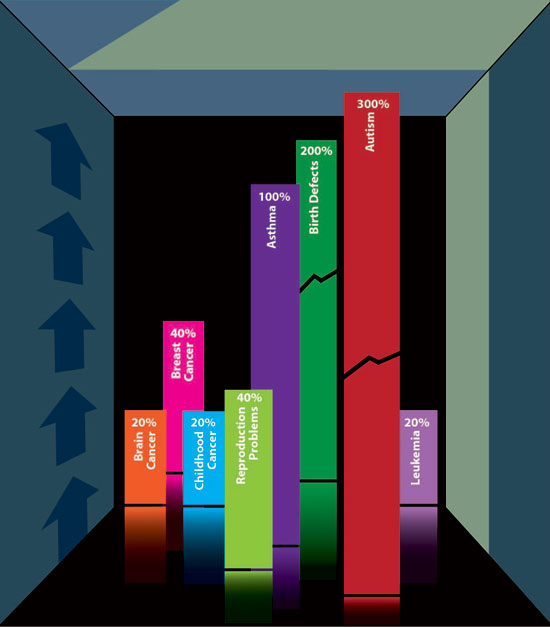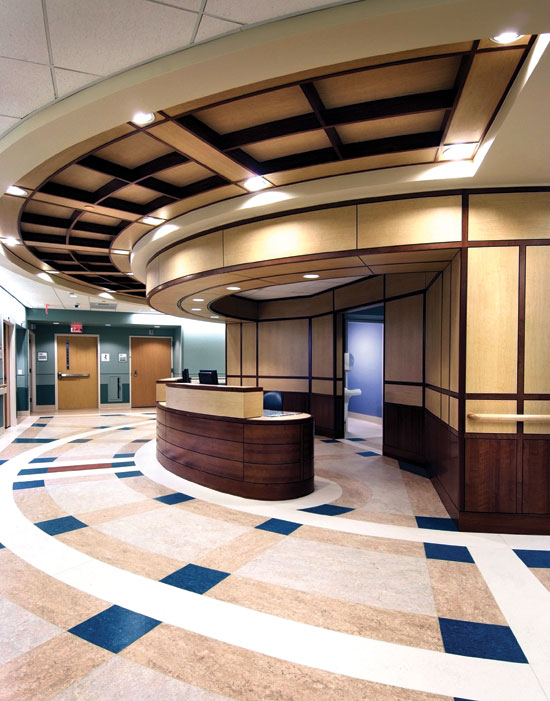Creating Healthy Healthcare Environments
Indoor Environmental Quality Issues
In the last half of the 20th century, according to the United Nations' Millennium Ecosystem Assessment, humans have changed their ecosystem more rapidly and extensively than in any comparable time in human history. The creation of a resultant “chemical society” has been a long-term concern of governments worldwide. In 1995, the United Nations called for global action to remove persistent organic pollutants (POPs) from our environment. The worldwide Stockholm Convention created an international treaty aiming to eliminate POPs from production and use. Unfortunately, the United States is one of only seven nations worldwide that has failed to ratify the treaty yet.

Chart courtesy of Forbo Flooring Systems
Studies are finding an alarming rate of links between increases in chronic diseases and the built environment.
The consequences of ecological change and increased presence of chemical pollutants are starting to be associated with alarming increases in chronic diseases. The jump is particularly pronounced in diseases that have suspected links to hazardous chemicals present in building materials like vinyl flooring, wallpaper, and other products that use polyvinyl chloride (PVC). Numerous studies have shown PVC to be the single largest material source of dioxin to the global environment over the course of its life cycle including production, use, and disposal. Diseases linked to this exposure include childhood leukemia, brain cancer, and other childhood cancers that have increased by more than 20 percent since 1975. Studies have shown that the birth of males with undescended testicles has increased 200 percent between 1970 and 1993. In women, breast cancer rates increased by 40 percent between 1973 and 1998 and 40 percent more women had difficulty conceiving a child in 2002 than in 1982, with a particularly sharp increase in reproductive difficulty among younger women ages 18–25. In general, asthma was twice as common in 1995 as it was in 1980 and autism spectrum disorders have become 10 times more frequent today than in the 1990s. These health facts are becoming increasingly difficult to ignore. Levels of bio-accumulative phthalates, dioxins, mercury, lead, and cadmium used in our built environment must be addressed. The need is becoming more profound as we create indoor environments that are more airtight in the name of energy efficiency. This trend is especially significant in healthcare environments, which are filled with patients whose diseases could be aggravated by environmental toxins.
While patients may be the focus of a healthcare environment, doctors, nurses, and other medical professionals are equally at risk. Surprisingly, very little has been done to protect U.S. health professionals from exposure to hazardous chemicals in their indoor environment. Some of these professionals have become concerned enough about the lack of control over chemical exposure that they have created an organization called Healthcare Without Harm (www.noharm.org). In the stated view of a representative of this global coalition of hospitals and healthcare systems, “by using excess energy, polluting the environment with phthalates, mercury, and other toxic chemicals, and producing waste which is burned rather than recycled, healthcare is ultimately compromising public health and damaging the ability of future generations to meet their needs.” Related to the burning of medical waste and other materials containing toxins, it is important to remember that quite often when toxins go into an incinerator it often means toxins come out of an incinerator. Fortunately, their message is getting through as they pursue improvements to hospital, clinic, specialty care and long-term care interior environments. One bright spot is the agreement to eliminate the use of any PBT phthalates, a class of chemicals used to make polyvinyl chloride (PVC) plastics flexible. These chemicals have been specifically targeted since they pose specific, identifiable threats to occupants of healthcare environments. Studies of phthalate exposure in the hospital setting point to the possibility of retarded sexual development among babies with high blood phthalate levels. A larger threat exists for healthcare workers who can often experience heightened phthalate exposure over many years, leading to the potential for allergies, cancers (especially breast cancer), and endocrine disruption, plus a host of other risks from obesity and diabetes to liver disease and infertility.

Photo by Fred Gerlich Photography; courtesy of Forbo Flooring Systems
McLeod Health Systems in Florence, South Carolina
The good news is that the products to solve the problem are already in the marketplace. PBT phthalates can be readily eliminated from an interior environment by choosing from the alternate, existing, and available building products that have never contained them and will never need to. All we need is the willingness of building designers, facility owners, and maintenance professionals to put them to use.









